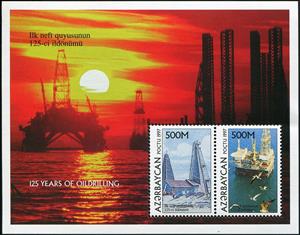Souvenir Sheet: 125 Yars Of Oildrilling (Azerbaijan 1997)
125 Yars Of Oildrilling (Azerbaijan 1997)
18 August (Azerbaijan ) within release 125 Years of Oildrilling goes into circulation Souvenir Sheet 125 Yars Of Oildrilling face value 2*500 Azerbaijani manat
| Souvenir Sheet 125 Yars Of Oildrilling in catalogues | |
|---|---|
| Michel: | Mi: AZ 392-393 |
Souvenir Sheet is horizontal format.
AZ 392 - Drilling rigs in Apsheron XIX century AZ 393 - Drilling platform XX centiryAlso in the issue 125 Years of Oildrilling:
- Souvenir Sheet - 125 Yars Of Oildrilling face value 2*500;
- Stamp - Early oil derricks, building face value 500;
- Stamp - Off-shore oil drilling platform face value 500;
Souvenir Sheet 125 Yars Of Oildrilling it reflects the thematic directions:
Birds (Aves), a subgroup of Reptiles, are the last living examples of Dinosaurs. They are a group of endothermic vertebrates, characterised by feathers, toothless beaked jaws, the laying of hard-shelled eggs, a high metabolic rate, a four-chambered heart, and a strong yet lightweight skeleton. Birds live worldwide and range in size from the 5 cm (2 in) bee hummingbird to the 2.75 m (9 ft) ostrich. They rank as the class of tetrapods with the most living species, at approximately ten thousand, with more than half of these being passerines, sometimes known as perching birds. Birds are the closest living relatives of crocodilians.
An oil well is a drillhole boring in Earth that is designed to bring petroleum oil hydrocarbons to the surface. Usually some natural gas is released as associated petroleum gas along with the oil. A well that is designed to produce only gas may be termed a gas well. Wells are created by drilling down into an oil or gas reserve and if necessary equipped with extraction devices such as pumpjacks. Creating the wells can be an expensive process, costing at least hundreds of thousands of dollars, and costing much more when in difficult-to-access locations, e.g., offshore. The process of modern drilling for wells first started in the 19th century but was made more efficient with advances to oil drilling rigs and technology during the 20th century.
A sea is a large body of salty water. There are particular seas and the sea. The sea commonly refers to the World Ocean, the wider body of seawater. Particular seas are either marginal seas, second-order sections of the oceanic sea (e.g. the Mediterranean Sea), or certain large, nearly landlocked bodies of water.
The Sun, also known as Sol, is a star at the center of the solar system. It is a white star that gives off different types of energy such as infrared energy (heat), ultraviolet light, radio waves and light. It also gives off a stream of particles, which reaches Earth as "solar wind". The source of all this energy is nuclear fusion. Nuclear fusion is the reaction in the star which turns hydrogen into helium and makes huge amounts of energy. It is a nearly perfect ball of hot plasma.




